 Click To Return To Main Page |
 |
||||||||
 News |
 Eco-Journalists |
 Articles |
 Games |
 Links |
 Facts 'n Fun |
 Email Us |
 About Us |
 Guestbook |
|
|
Harry the Blue Tongue Lizard
Owning a pet is a responsibility and recently we found out just how much of a responsibility it can be. Harry the Blue-tongue Lizard. You can see the puncture wounds in his side
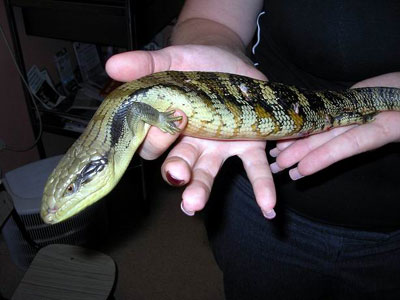 Border Collies are bred to respond to movement. So take one bored Border Collie and a Blue Tongue Lizard who was cruising around looking for a hot rock to bask on....disaster!
Border Collies are bred to respond to movement. So take one bored Border Collie and a Blue Tongue Lizard who was cruising around looking for a hot rock to bask on....disaster!We found the lizard in our garden with puncture marks in his sides and bleeding heavily. He was still alive so we put him in a dark box with a damp towel at the bottom and rushed to our local friendly vet, Lewis Buckingham (who is brilliant in emergencies). Harry and Emily - a quick photo opportunity before
being whisked off to Blue-tongue heaven - heat pads and good grub! 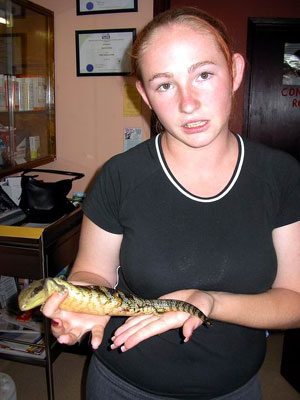 When we got there, he seemed to be leaking air from his sides (the lizard, not the vet!) so we presumed that one of his lungs was punctured and that meant his chances of surviving were small. We left him in the capable hands of Emily, the vet nurse and went home to tell Gyp, our Border Collie, what we thought of him.
When we got there, he seemed to be leaking air from his sides (the lizard, not the vet!) so we presumed that one of his lungs was punctured and that meant his chances of surviving were small. We left him in the capable hands of Emily, the vet nurse and went home to tell Gyp, our Border Collie, what we thought of him.The next day, we rang Mr Buckingham, the vet, to see how the lizard was and were shocked to find out that he was still alive! Emily told us that they were keeping him on a heated pad and giving him fluids to replace the blood he lost. After checking-in occasionally with Emily, we finally got the OK to take him back home (we'd named him 'Harry' after Harry Houdini because he had tried to escape several times during his stay). Mr Buckingham told us that the air we saw leaking wasn't from his lungs, it was because Blue Tongue Lizards will inflate themselves with air when they get scared. We also found out that when Emily cleaned Harry, she found something rather unusual lurking between his toes. Bush tics! These bush ticks feed off the blood of animals...and humans. They can easily kill a dog, but for some reason, they don't kill lizards even though they are much smaller than a dog. Make sure you read the story 'No Tick of Approval!' for more info on these critters. Total recovery....one lucky Blue-tongue! Here he enjoying a bit of fuss from Immy.
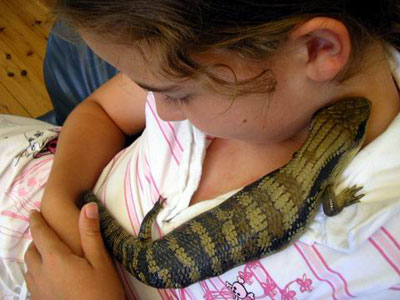 When we tried to take Harry away, he didn't want to leave probably because of all of the attention he had been given and also his little pen with a heated mat and a constant supply of food.
When we tried to take Harry away, he didn't want to leave probably because of all of the attention he had been given and also his little pen with a heated mat and a constant supply of food.We found a nice sunny, rocky area, perfect for a cold-blooded lizard and released him back into the wild. With native animals, it's important to release them back into the wild and not to get attached to them. This was hard with Harry as he had become quite comfortable being handled. It's also important that they are released back into the same place that they come from. There was no way that we would put him back into our garden as Gyp would just attack him again so we put him on the other side of the fence in a nearby park. He's quite happy here as he has got used to being handled
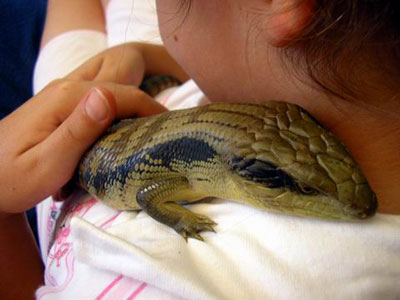 We didn't want to experience this again so I talked to Mr. Buckingham about how we could prevent Gyp from attacking anymore lizards. He told me that the reason for his attack was that dogs get bored. It's hard to give a dog all the attention they need as they have a pretty short attention span.
We didn't want to experience this again so I talked to Mr. Buckingham about how we could prevent Gyp from attacking anymore lizards. He told me that the reason for his attack was that dogs get bored. It's hard to give a dog all the attention they need as they have a pretty short attention span. You won't be able to stop your pets from doing this, but getting them a fun toy to play with might help. You don't have to go out and spend a fortune on chew toys. There are rubber toys called 'Kongs' that you can buy from a pet shop. You can put some peanut butter inside and the dog will spend ages happily attempting to lick it out. The only way to stop native animals being hurt or killed is to fence off the area where your dog is. This may not be possible in your garden. The biggest killers of native animals are cats. Make sure you keep cats in at night or even better, don't choose a cat as a pet in the first place! You might think that this is a bit too much trouble just to save a lizard - but Blue-Tongue Lizards can live up to 30 years...that's a lot longer than your dog or cat!!! Alastair releasing Harry - his new home has plenty of shrub cover,
rocks to bask on, water nearby and is away from dogs 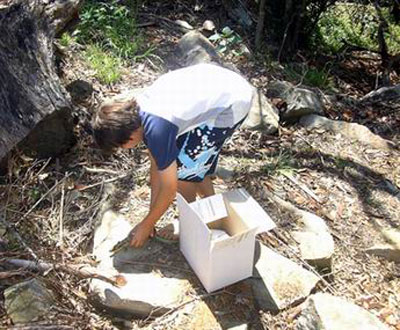 BLUE -TONGUE FACTS
BLUE -TONGUE FACTS
Many people in Australia will have a Blue-tongue living around their garden - don't try to pick one up...they have sharp teeth and can bite. Also, don't try to tame one by feeding it dog food. Leave it to be a creature of the wild, just like they're meant to be. If you find an injured wild animal either take it to your local vet or call a wildlife rescue organisation like WIRES. Phone:1800 641 188 (in NSW only) http://www.wires.org.au By Alastair Wadlow
Information sourced from: Australian Museum Online: www.amonline.net.au/factsheets/blue_tongue_lizard.htm
Australian Broadcasting Corporation: www.abc.net.au/schoolstv/animals/BLUE-TONGUEDLIZARDS.htm A huge 'thank you' to Lewis Buckingham, our vet, and Emily his animal nurse. |